
Illegal excavators looting 2,000-year-old site in Iran
Seven years ago a team of Iranian and Italian archeological experts carried out archeological excavations in an ancient site in southwestern Iran.
The site is called Kaleh Chendar and is located near the city of Izeh in Khuzestan Province.
The archeological team was able to discover a large collection of Elymai tombs, dating back 2,000 years, along with prayer platforms and the remains of residential spaces.
The archeologists could not return to this ancient site to complete their explorations. So they urgently restored everything they found and buried many parts of their findings in the ground so that they would not be damaged. But their efforts failed to keep unauthorized excavators away from the site.
These illegal excavators seized the opportunity and carried out digging operations in the region. They destroyed some of the findings of the archeologists and attempted to steal two big tomb stones which weighed around 1,000 kilograms. Shepherds and herdsmen also confirm their presence in the ancient site of Kaleh Chendar.
The ancient site has been abandoned, and there are no guard posts or petrol units around it, which paves the ground for illegal excavators to continue their activities.
The Shami statue was discovered in Kaleh Chendar some 80 years ago. One of the main surviving works of Parthian art, it is currently held in the National Museum of Iran.
Depicting a man, the bronze statue is 1.94 meters high. Some scholars believe that it was made by Greek or Roman sculptors. Others argue that it was produced in Palmyra (Syria), or by an artist from this city. It is also believed that the statue was made in Susa (in modern day Iran).
Elymais was an ancient Parthian vassal state located east of the lower Tigris River and usually considered part of the larger district of Susiana. It incorporated much of the area of the biblical region of Elam, approximately equivalent to the modern region of Khuzestan Province, Iran. The heart of the kingdom centered near the mountains of Lorestan, near modern Behbehan and Izeh, where the local dynasty left inscriptions in a form of Aramaic.







